Note
Click here to download the full example code or to run this example in your browser via Binder
2D MAF data of Na2O.4.7SiO2 glass¶
The following example illustrates an application of the statistical learning method applied in determining the distribution of the nuclear shielding tensor parameters from a 2D magic-angle flipping (MAF) spectrum. In this example, we use the 2D MAF spectrum 1 of \(\text{Na}_2\text{O}\cdot4.7\text{SiO}_2\) glass.
Before getting started¶
Import all relevant packages.
import csdmpy as cp
import matplotlib.pyplot as plt
import numpy as np
from matplotlib import cm
from csdmpy import statistics as stats
from mrinversion.kernel.nmr import ShieldingPALineshape
from mrinversion.kernel.utils import x_y_to_zeta_eta
from mrinversion.linear_model import SmoothLasso, TSVDCompression
from mrinversion.utils import plot_3d, to_Haeberlen_grid
Setup for the matplotlib figures.
# function for plotting 2D dataset
def plot2D(csdm_object, **kwargs):
plt.figure(figsize=(4.5, 3.5))
ax = plt.subplot(projection="csdm")
ax.imshow(csdm_object, cmap="gist_ncar_r", aspect="auto", **kwargs)
ax.invert_xaxis()
ax.invert_yaxis()
plt.tight_layout()
plt.show()
Dataset setup¶
Import the dataset¶
Load the dataset. Here, we import the dataset as the CSDM data-object.
# The 2D MAF dataset in csdm format
filename = "https://zenodo.org/record/3964531/files/Na2O-4_74SiO2-MAF.csdf"
data_object = cp.load(filename)
# For inversion, we only interest ourselves with the real part of the complex dataset.
data_object = data_object.real
# We will also convert the coordinates of both dimensions from Hz to ppm.
_ = [item.to("ppm", "nmr_frequency_ratio") for item in data_object.dimensions]
Here, the variable data_object is a
CSDM
object that holds the real part of the 2D MAF dataset. The plot of the 2D MAF dataset
is
plot2D(data_object)
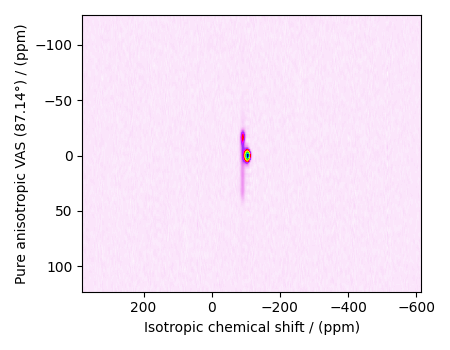
There are two dimensions in this dataset. The dimension at index 0, the horizontal dimension in the figure, is the isotropic chemical shift dimension, while the dimension at index 1 is the pure anisotropic dimension. The number of coordinates along the respective dimensions is
print(data_object.shape)
Out:
(320, 128)
with 320 points along the isotropic chemical shift dimension (index 0) and 128 points along the anisotropic dimension (index 1).
Prepping the data for inversion¶
Step-1: Data Alignment
When using the csdm objects with the mrinversion package, the dimension at index
0 must be the dimension undergoing the linear inversion. In this example, we plan to
invert the pure anisotropic shielding line-shape. In the data_object, however,
the anisotropic dimension is at index 1. Transpose the dimensions as follows,
Step-2: Optimization
Also notice, the signal from the 2D MAF dataset occupies a small fraction of the two-dimensional frequency grid. For optimum performance, truncate the dataset to the relevant region before proceeding. Use the appropriate array indexing/slicing to select the signal region.
data_object_truncated = data_object[:, 155:180]
plot2D(data_object_truncated)

Linear Inversion setup¶
Dimension setup¶
Anisotropic-dimension:
The dimension of the dataset that holds the pure anisotropic frequency
contributions. In mrinversion, this must always be the dimension at index 0 of
the data object.
x-y dimensions: The two inverse dimensions corresponding to the x and y-axis of the x-y grid.
inverse_dimensions = [
cp.LinearDimension(count=25, increment="400 Hz", label="x"), # the `x`-dimension.
cp.LinearDimension(count=25, increment="400 Hz", label="y"), # the `y`-dimension.
]
Generating the kernel¶
For MAF datasets, the line-shape kernel corresponds to the pure nuclear shielding
anisotropy line-shapes. Use the
ShieldingPALineshape class to generate
a shielding line-shape kernel.
lineshape = ShieldingPALineshape(
anisotropic_dimension=anisotropic_dimension,
inverse_dimension=inverse_dimensions,
channel="29Si",
magnetic_flux_density="9.4 T",
rotor_angle="87.14°",
rotor_frequency="14 kHz",
number_of_sidebands=4,
)
Here, lineshape is an instance of the
ShieldingPALineshape class. The required
arguments of this class are the anisotropic_dimension, inverse_dimension, and
channel. We have already defined the first two arguments in the previous
sub-section. The value of the channel argument is the nucleus observed in the MAF
experiment. In this example, this value is ‘29Si’.
The remaining arguments, such as the magnetic_flux_density, rotor_angle,
and rotor_frequency, are set to match the conditions under which the 2D MAF
spectrum was acquired. Note for this particular MAF measurement, the rotor angle was
set to \(87.14^\circ\) for the anisotropic dimension, not the usual
\(90^\circ\). The value of the
number_of_sidebands argument is the number of sidebands calculated for each
line-shape within the kernel. Unless, you have a lot of spinning sidebands in your
MAF dataset, four sidebands should be enough.
Once the ShieldingPALineshape instance is created, use the
kernel() method of the
instance to generate the MAF line-shape kernel.
Out:
(128, 625)
The kernel K is a NumPy array of shape (128, 625), where the axes with 128 and
625 points are the anisotropic dimension and the features (x-y coordinates)
corresponding to the \(25\times 25\) x-y grid, respectively.
Data Compression¶
Data compression is optional but recommended. It may reduce the size of the inverse problem and, thus, further computation time.
new_system = TSVDCompression(K, data_object_truncated)
compressed_K = new_system.compressed_K
compressed_s = new_system.compressed_s
print(f"truncation_index = {new_system.truncation_index}")
Out:
compression factor = 1.471264367816092
truncation_index = 87
Solving the inverse problem¶
Smooth LASSO cross-validation¶
Solve the smooth-lasso problem. Ordinarily, one should use the statistical learning method to solve the inverse problem over a range of α and λ values and then determine the best nuclear shielding tensor parameter distribution for the given 2D MAF dataset. Considering the limited build time for the documentation, we skip this step and evaluate the distribution at pre-optimized α and λ values. The optimum values are \(\alpha = 2.07\times 10^{-7}\) and \(\lambda = 7.85\times 10^{-6}\). The following commented code was used in determining the optimum α and λ values.
# from mrinversion.linear_model import SmoothLassoCV
# # setup the pre-defined range of alpha and lambda values
# lambdas = 10 ** (-4 - 3 * (np.arange(20) / 19))
# alphas = 10 ** (-4 - 3 * (np.arange(20) / 19))
# # setup the smooth lasso cross-validation class
# s_lasso = SmoothLassoCV(
# alphas=alphas, # A numpy array of alpha values.
# lambdas=lambdas, # A numpy array of lambda values.
# sigma=0.003, # The standard deviation of noise from the MAF data.
# folds=10, # The number of folds in n-folds cross-validation.
# inverse_dimension=inverse_dimensions, # previously defined inverse dimensions.
# verbose=1, # If non-zero, prints the progress as the computation proceeds.
# max_iterations=20000, # maximum number of allowed iterations.
# )
# # run fit using the compressed kernel and compressed data.
# s_lasso.fit(compressed_K, compressed_s)
# # the optimum hyper-parameters, alpha and lambda, from the cross-validation.
# print(s_lasso.hyperparameters)
# # {'alpha': 2.06913808111479e-07, 'lambda': 7.847599703514622e-06}
# # the solution
# f_sol = s_lasso.f
# # the cross-validation error curve
# CV_metric = s_lasso.cross_validation_curve
If you use the above SmoothLassoCV method, skip the following code-block. The
following code-block evaluates the smooth-lasso solution at the pre-optimized
hyperparameters.
# Setup the smooth lasso class
s_lasso = SmoothLasso(
alpha=2.07e-7, lambda1=7.85e-6, inverse_dimension=inverse_dimensions
)
# run the fit method on the compressed kernel and compressed data.
s_lasso.fit(K=compressed_K, s=compressed_s)
The optimum solution¶
The f attribute of the instance holds
the solution,
where f_sol is the optimum solution.
The fit residuals¶
To calculate the residuals between the data and predicted data(fit), use the
residuals() method, as follows,
residuals = s_lasso.residuals(K=K, s=data_object_truncated)
# residuals is a CSDM object.
# The plot of the residuals.
plot2D(residuals, vmax=data_object_truncated.max(), vmin=data_object_truncated.min())
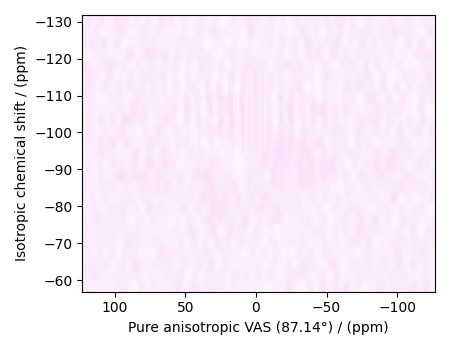
The mean and standard deviation of the residuals are
Out:
(<Quantity 0.00082075>, <Quantity 0.00353747>)
Saving the solution¶
To serialize the solution to a file, use the save() method of the CSDM object, for example,
f_sol.save("Na2O.4.7SiO2_inverse.csdf") # save the solution
residuals.save("Na2O.4.7SiO2_residue.csdf") # save the residuals
Data Visualization¶
At this point, we have solved the inverse problem and obtained an optimum distribution of the nuclear shielding tensor parameters from the 2D MAF dataset. You may use any data visualization and interpretation tool of choice for further analysis. In the following sections, we provide minimal visualization and analysis to complete the case study.
Visualizing the 3D solution¶
# Normalize the solution
f_sol /= f_sol.max()
# Convert the coordinates of the solution, `f_sol`, from Hz to ppm.
[item.to("ppm", "nmr_frequency_ratio") for item in f_sol.dimensions]
# The 3D plot of the solution
plt.figure(figsize=(5, 4.4))
ax = plt.subplot(projection="3d")
plot_3d(ax, f_sol, x_lim=[0, 140], y_lim=[0, 140], z_lim=[-50, -150])
plt.tight_layout()
plt.show()
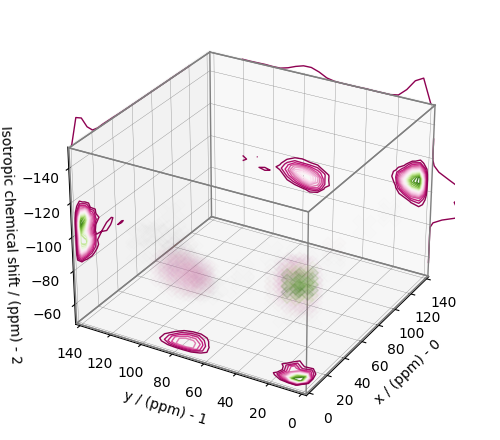
From the 3D plot, we observe two distinct regions: one for the \(\text{Q}^4\) sites and another for the \(\text{Q}^3\) sites. Select the respective regions by using the appropriate array indexing,
Q4_region = f_sol[0:8, 0:8, 3:18]
Q4_region.description = "Q4 region"
Q3_region = f_sol[0:8, 11:22, 8:20]
Q3_region.description = "Q3 region"
The plot of the respective regions is shown below.
# Calculate the normalization factor for the 2D contours and 1D projections from the
# original solution, `f_sol`. Use this normalization factor to scale the intensities
# from the sub-regions.
max_2d = [
f_sol.sum(axis=0).max().value,
f_sol.sum(axis=1).max().value,
f_sol.sum(axis=2).max().value,
]
max_1d = [
f_sol.sum(axis=(1, 2)).max().value,
f_sol.sum(axis=(0, 2)).max().value,
f_sol.sum(axis=(0, 1)).max().value,
]
plt.figure(figsize=(5, 4.4))
ax = plt.subplot(projection="3d")
# plot for the Q4 region
plot_3d(
ax,
Q4_region,
x_lim=[0, 140], # the x-limit
y_lim=[0, 140], # the y-limit
z_lim=[-50, -150], # the z-limit
max_2d=max_2d, # normalization factors for the 2D contours projections
max_1d=max_1d, # normalization factors for the 1D projections
cmap=cm.Reds_r, # colormap
box=True, # draw a box around the region
)
# plot for the Q3 region
plot_3d(
ax,
Q3_region,
x_lim=[0, 140], # the x-limit
y_lim=[0, 140], # the y-limit
z_lim=[-50, -150], # the z-limit
max_2d=max_2d, # normalization factors for the 2D contours projections
max_1d=max_1d, # normalization factors for the 1D projections
cmap=cm.Blues_r, # colormap
box=True, # draw a box around the region
)
ax.legend()
plt.tight_layout()
plt.show()
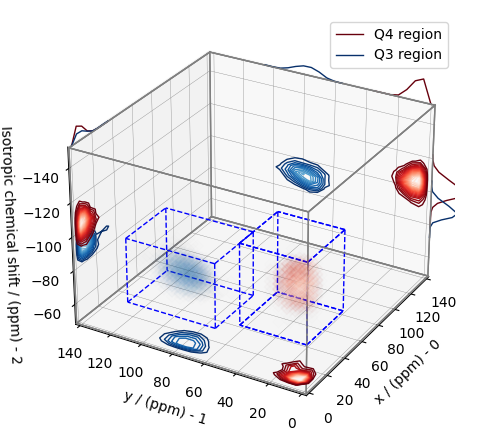
Visualizing the isotropic projections.¶
Because the \(\text{Q}^4\) and \(\text{Q}^3\) regions are fully resolved after the inversion, evaluating the contributions from these regions is trivial. For examples, the distribution of the isotropic chemical shifts for these regions are
# Isotropic chemical shift projection of the 2D MAF dataset.
data_iso = data_object_truncated.sum(axis=0)
data_iso /= data_iso.max() # normalize the projection
# Isotropic chemical shift projection of the tensor distribution dataset.
f_sol_iso = f_sol.sum(axis=(0, 1))
# Isotropic chemical shift projection of the tensor distribution for the Q4 region.
Q4_region_iso = Q4_region.sum(axis=(0, 1))
# Isotropic chemical shift projection of the tensor distribution for the Q3 region.
Q3_region_iso = Q3_region.sum(axis=(0, 1))
# Normalize the three projections.
f_sol_iso_max = f_sol_iso.max()
f_sol_iso /= f_sol_iso_max
Q4_region_iso /= f_sol_iso_max
Q3_region_iso /= f_sol_iso_max
# The plot of the different projections.
plt.figure(figsize=(5.5, 3.5))
ax = plt.subplot(projection="csdm")
ax.plot(f_sol_iso, "--k", label="tensor")
ax.plot(Q4_region_iso, "r", label="Q4")
ax.plot(Q3_region_iso, "b", label="Q3")
ax.plot(data_iso, "-k", label="MAF")
ax.plot(data_iso - f_sol_iso - 0.1, "gray", label="residuals")
ax.set_title("Isotropic projection")
ax.invert_xaxis()
plt.legend()
plt.tight_layout()
plt.show()
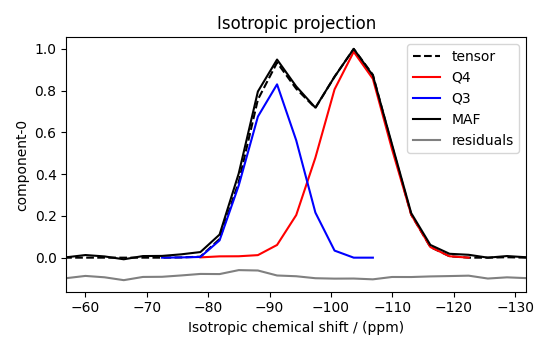
Analysis¶
For the analysis, we use the statistics module of the csdmpy package. Following is the moment analysis of the 3D volumes for both the \(\text{Q}^4\) and \(\text{Q}^3\) regions up to the second moment.
int_Q4 = stats.integral(Q4_region) # volume of the Q4 distribution
mean_Q4 = stats.mean(Q4_region) # mean of the Q4 distribution
std_Q4 = stats.std(Q4_region) # standard deviation of the Q4 distribution
int_Q3 = stats.integral(Q3_region) # volume of the Q3 distribution
mean_Q3 = stats.mean(Q3_region) # mean of the Q3 distribution
std_Q3 = stats.std(Q3_region) # standard deviation of the Q3 distribution
print("Q4 statistics")
print(f"\tpopulation = {100 * int_Q4 / (int_Q4 + int_Q3)}%")
print("\tmean\n\t\tx:\t{0}\n\t\ty:\t{1}\n\t\tiso:\t{2}".format(*mean_Q4))
print("\tstandard deviation\n\t\tx:\t{0}\n\t\ty:\t{1}\n\t\tiso:\t{2}".format(*std_Q4))
print("Q3 statistics")
print(f"\tpopulation = {100 * int_Q3 / (int_Q4 + int_Q3)}%")
print("\tmean\n\t\tx:\t{0}\n\t\ty:\t{1}\n\t\tiso:\t{2}".format(*mean_Q3))
print("\tstandard deviation\n\t\tx:\t{0}\n\t\ty:\t{1}\n\t\tiso:\t{2}".format(*std_Q3))
Out:
Q4 statistics
population = 60.431500025334195%
mean
x: 8.658929882586538 ppm
y: 9.078020025458393 ppm
iso: -103.68408725692224 ppm
standard deviation
x: 4.146921993257621 ppm
y: 4.308903694091187 ppm
iso: 5.32609949115569 ppm
Q3 statistics
population = 39.568499974665805%
mean
x: 10.33796931278282 ppm
y: 78.89916156526402 ppm
iso: -90.6075658419838 ppm
standard deviation
x: 6.056163594303801 ppm
y: 7.725108784985181 ppm
iso: 3.996705671525037 ppm
The statistics shown above are according to the respective dimensions, that is, the
x, y, and the isotropic chemical shifts. To convert the x and y statistics
to commonly used \(\zeta_\sigma\) and \(\eta_\sigma\) statistics, use the
x_y_to_zeta_eta() function.
mean_ζη_Q3 = x_y_to_zeta_eta(*mean_Q3[0:2])
# error propagation for calculating the standard deviation
std_ζ = (std_Q3[0] * mean_Q3[0]) ** 2 + (std_Q3[1] * mean_Q3[1]) ** 2
std_ζ /= mean_Q3[0] ** 2 + mean_Q3[1] ** 2
std_ζ = np.sqrt(std_ζ)
std_η = (std_Q3[1] * mean_Q3[0]) ** 2 + (std_Q3[0] * mean_Q3[1]) ** 2
std_η /= (mean_Q3[0] ** 2 + mean_Q3[1] ** 2) ** 2
std_η = (4 / np.pi) * np.sqrt(std_η)
print("Q3 statistics")
print(f"\tpopulation = {100 * int_Q3 / (int_Q4 + int_Q3)}%")
print("\tmean\n\t\tζ:\t{0}\n\t\tη:\t{1}\n\t\tiso:\t{2}".format(*mean_ζη_Q3, mean_Q3[2]))
print(
"\tstandard deviation\n\t\tζ:\t{0}\n\t\tη:\t{1}\n\t\tiso:\t{2}".format(
std_ζ, std_η, std_Q3[2]
)
)
Out:
Q3 statistics
population = 39.568499974665805%
mean
ζ: 79.57355908349001 ppm
η: 0.16588453894349856
iso: -90.6075658419838 ppm
standard deviation
ζ: 7.699941421850818 ppm
η: 0.09741486737518291
iso: 3.996705671525037 ppm
Result cross-verification¶
The reported value for the Qn-species distribution from Baltisberger et. al. 1 is listed below and is consistent with the above result.
Species |
Yield |
Isotropic chemical shift, \(\delta_\text{iso}\) |
Shielding anisotropy, \(\zeta_\sigma\): |
Shielding asymmetry, \(\eta_\sigma\): |
|---|---|---|---|---|
Q4 |
\(57.8 \pm 0.1\) % |
\(-103.7 \pm 5.31\) ppm |
0 ppm (fixed) |
0 (fixed) |
Q3 |
\(42.2 \pm 0.2\) % |
\(-90.5 \pm 4.29\) ppm |
79.8 ppm with a 7.1 ppm Gaussian broadening |
0 (fixed) |
Convert the 3D tensor distribution in Haeberlen parameters¶
You may re-bin the 3D tensor parameter distribution from a \(\rho(\delta_\text{iso}, x, y)\) distribution to \(\rho(\delta_\text{iso}, \zeta_\sigma, \eta_\sigma)\) distribution as follows.
# Create the zeta and eta dimensions, as shown below.
zeta = cp.as_dimension(np.arange(40) * 4 - 40, unit="ppm", label="zeta")
eta = cp.as_dimension(np.arange(16) / 15, label="eta")
# Use the `to_Haeberlen_grid` function to convert the tensor parameter distribution.
fsol_Hae = to_Haeberlen_grid(f_sol, zeta, eta)
The 3D plot¶
plt.figure(figsize=(5, 4.4))
ax = plt.subplot(projection="3d")
plot_3d(ax, fsol_Hae, x_lim=[0, 1], y_lim=[-40, 120], z_lim=[-50, -150], alpha=0.4)
plt.tight_layout()
plt.show()
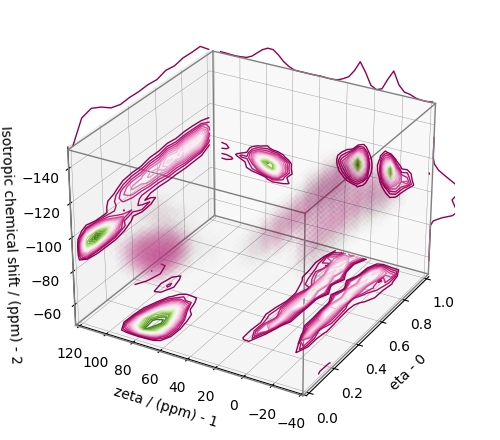
References¶
- 1(1,2)
Baltisberger, J. H., Florian, P., Keeler, E. G., Phyo, P. A., Sanders, K. J., Grandinetti, P. J.. Modifier cation effects on 29Si nuclear shielding anisotropies in silicate glasses, J. Magn. Reson., 268, (2016), 95 – 106. doi:10.1016/j.jmr.2016.05.003.
Total running time of the script: ( 0 minutes 8.158 seconds)
